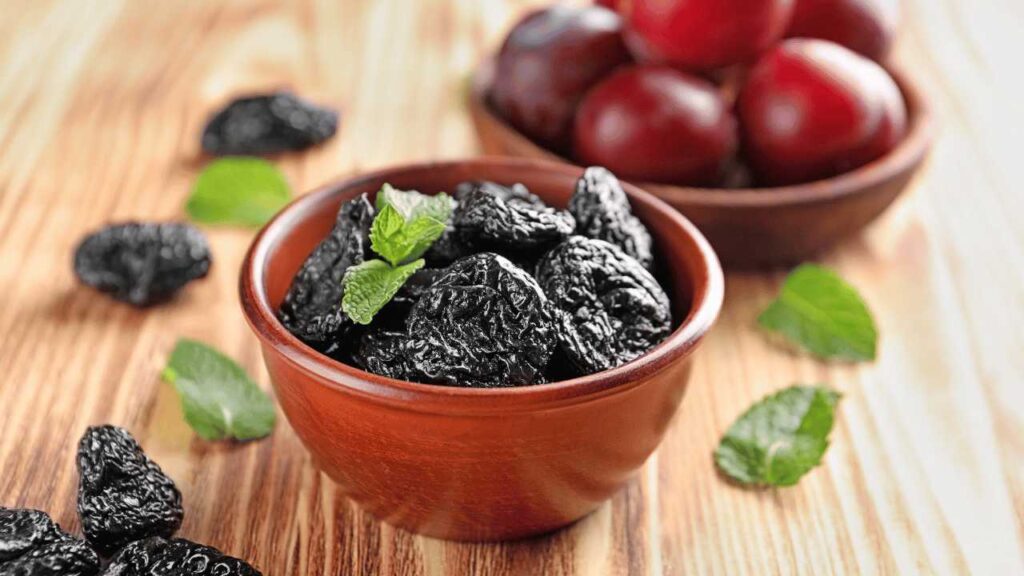Dried Prunes
Prunes are dried plums. They have a wrinkled appearance and a sweet, rich flavor. Dried Prunes are known for their high fiber content, which can help with digestion. They’re also a good source of vitamins and minerals, such as potassium and vitamin K. Prunes can be enjoyed on their own as a snack or used in various recipes, like baked goods or stews. Some people even use them to make prune juice. They’re a tasty and nutritious addition to a balanced diet.
How Dried Prunes Make?
Prunes grow on trees, just like regular plums. The process starts with plum trees that produce the fruit. When the plums are ripe, they are harvested from the trees. To make prunes, the plums are then dried, either naturally in the sun or through artificial drying methods. The drying process removes most of the moisture from the plums, resulting in the wrinkled and shriveled appearance of prunes. Once dried, the prunes can be packaged and enjoyed as a delicious and nutritious snack. It’s fascinating how the drying process transforms plums into prunes.
Cultivation Of Prunes
Prunes are grown in various countries around the world. Some of the major producers of prunes include the United States, particularly in California. Other countries known for prune production include France, Chile, Argentina, and Serbia. These regions have favorable climates and conditions for growing plums, which are then dried to make prunes. Prunes are enjoyed globally and are used in a variety of culinary applications. So, no matter where you are, you can likely find prunes in your local market.
Types Of Prunes
There are different types of prunes, which can vary in size, color, and flavor. Some popular types of prunes include:
- French Prunes: These prunes are known for their sweet and rich flavor. They are often dark purple in color.
- California Prunes: California is a major producer of prunes, and their prunes are known for their large size and sweet taste.
- Agen Prunes: Agen prunes are named after the region in France where they are grown. They are known for their small size and intense flavor.
- Greengage Prunes: Greengage prunes are a variety of green plums that are dried to make prunes. They have a unique tart and sweet taste.
These are just a few examples, but there are other types of prunes as well. Each type may have its own distinct characteristics.
Benefits Of Prunes
Prunes have several benefits that make them a great addition to a healthy diet. Here are some of the benefits of prunes:
- Digestive Health: Prunes are rich in dietary fiber, which can help promote regular bowel movements and prevent constipation.
- Nutrient-Rich: Prunes are packed with essential vitamins and minerals, including vitamin K, potassium, and antioxidants, which can support overall health.
- Bone Health: Prunes contain vitamin K and potassium, which are important for maintaining healthy bones and preventing bone-related conditions.
- Heart Health: Prunes are low in sodium and high in potassium, which can help maintain healthy blood pressure levels and support heart health.
- Antioxidant Properties: Prunes are a good source of antioxidants, which can help protect cells from damage caused by harmful free radicals.
Remember, it’s always a good idea to enjoy prunes as part of a balanced diet.
Dishes Of Dried Prunes
Prunes are a versatile ingredient that can be used in a variety of dishes. Here are a few popular dishes that feature prunes:
- Prune-Stuffed Pork Tenderloin: Prunes can be used to make a delicious stuffing for pork tenderloin, adding a sweet and tangy flavor to the dish.
- Prune Chicken Tagine: Prunes are a common ingredient in Moroccan cuisine, and they are often used in tagine dishes. The combination of chicken, spices, and prunes creates a flavorful and aromatic meal.
- Prune and Walnut Salad: Prunes can be a great addition to salads, adding a touch of sweetness and texture. Combine them with walnuts, greens, and your favorite dressing for a tasty and nutritious salad.
- Prune Compote: Prunes can be cooked down with a little sugar and spices to create a compote that can be enjoyed on its own or used as a topping for desserts like yogurt, ice cream, or pancakes.
These are just a few examples, but there are many more ways to incorporate prunes into your cooking.
Side Effects of Prune
The side effects of Dried prunes are
- Digestive Issues: Prunes are high in dietary fiber, which can help with digestion. However, consuming too many prunes at once may cause bloating, gas, or diarrhea in some individuals. It’s best to start with a small amount and gradually increase your intake to see how your body reacts.
- Sugar Content: Prunes are naturally sweet and contain natural sugars. If you have diabetes or are watching your sugar intake, it’s important to be mindful of the amount of prunes you consume, as they can affect blood sugar levels.
- Allergic Reactions: While rare, some individuals may be allergic to prunes or other dried fruits. If you experience any signs of an allergic reaction, such as itching, swelling, or difficulty breathing, it’s important to seek medical attention.
Remember, it’s always a good idea to listen to your body and consume prunes in moderation. If you have any concerns or specific health conditions, it’s best to consult with a healthcare professional.

